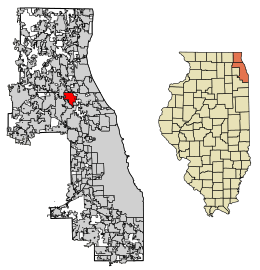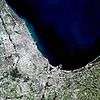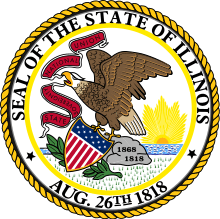Wheeling, Illinois
Wheeling is a village in Cook and Lake counties in the U.S. state of Illinois. A suburb of Chicago, it is primarily in Cook County, approximately 23 mi (37 km) northwest of downtown Chicago. The population was 37,648 at the 2010 census.[5] Wheeling is named for Wheeling, West Virginia.[6]
Wheeling, Illinois Village of Wheeling, Illinois | |
|---|---|
Village | |
| Motto(s): "Revolving Around Community" | |
 Location of Wheeling in Cook County, Illinois. | |
.svg.png) Location of Illinois in the United States | |
| Coordinates: 42°7′53″N 87°55′47″W | |
| Country | United States |
| State | Illinois |
| Counties | Cook, Lake |
| Founded | 1894 |
| Government | |
| • Type | Council-manager |
| • Village President | Pat Horcher[1] |
| • Manager | Jon A. Sfondilis |
| Area | |
| • Total | 8.73 sq mi (22.61 km2) |
| • Land | 8.67 sq mi (22.46 km2) |
| • Water | 0.06 sq mi (0.15 km2) |
| Elevation | 650 ft (200 m) |
| Population (2010) | |
| • Total | 37,648 |
| • Estimate (2019)[3] | 38,646 |
| • Density | 4,456.41/sq mi (1,720.60/km2) |
| Time zone | UTC−6 (CST) |
| • Summer (DST) | UTC−5 (CDT) |
| ZIP Code(s) | 60089, 60090 |
| Area code(s) | 847 and 224 |
| FIPS code | 17-81087 |
| GNIS feature ID | 421000[4] |
| Website | www |
Geography
According to the 2010 census, the village has a total area of 8.74 square miles (22.6 km2), of which 8.74 square miles (22.6 km2) (or 97.26%) is land and 0.24 square miles (0.62 km2) (or 2.74%) is water.[7]
Climate
The climate in Wheeling can be classified as temperate. Winters are usually very cold and snowy. Summers are often hot and humid, but can be pleasantly warm as well. Precipitation is uniformly distributed throughout the year.
| Climate data for Wheeling, Illinois | |||||||||||||
|---|---|---|---|---|---|---|---|---|---|---|---|---|---|
| Month | Jan | Feb | Mar | Apr | May | Jun | Jul | Aug | Sep | Oct | Nov | Dec | Year |
| Average high °F (°C) | 32 (0) |
36 (2) |
45 (7) |
57 (14) |
68 (20) |
78 (26) |
83 (28) |
81 (27) |
74 (23) |
62 (17) |
49 (9) |
36 (2) |
58.416 (14.68) |
| Average low °F (°C) | 16 (−9) |
19 (−7) |
28 (−2) |
38 (3) |
47 (8) |
57 (14) |
63 (17) |
62 (17) |
54 (12) |
42 (6) |
33 (1) |
20 (−7) |
36.916 (2.73) |
| Source: [8] | |||||||||||||
Demographics
| Historical population | |||
|---|---|---|---|
| Census | Pop. | %± | |
| 1890 | 811 | — | |
| 1900 | 331 | −59.2% | |
| 1910 | 260 | −21.5% | |
| 1920 | 313 | 20.4% | |
| 1930 | 467 | 49.2% | |
| 1940 | 550 | 17.8% | |
| 1950 | 916 | 66.5% | |
| 1960 | 7,169 | 682.6% | |
| 1970 | 13,243 | 84.7% | |
| 1980 | 23,266 | 75.7% | |
| 1990 | 29,911 | 28.6% | |
| 2000 | 34,496 | 15.3% | |
| 2010 | 37,648 | 9.1% | |
| Est. 2019 | 38,646 | [3] | 2.7% |
| U.S. Decennial Census[9] | |||
At the 2010 census there were 34,496 people, 13,280 households, and 8,459 families living in the village. The population density was 4,106.5 people per square mile (1,585.6/km²). There were 13,697 housing units at an average density of 1,630.5 per square mile (629.6/km²). The racial make-up of the village was 76.68% White, 2.44% African American, 0.23% Native American, 9.26% Asian, 0.07% Pacific Islander, 9.18% from other races, and 2.13% from two or more races. Hispanic or Latino of any race were 20.68%.[10]
Of the 13,280 households 31.5% had children under the age of 18 living with them, 51.1% were married couples living together, 9.0% had a female householder with no husband present, and 36.3% were non-families. 30.1% of households were one person and 8.2% were one person aged 65 or older. The average household size was 2.57 and the average family size was 3.26.
The age distribution was 23.4% under the age of 18, 9.4% from 18 to 24, 35.2% from 25 to 44, 21.8% from 45 to 64, and 10.2% 65 or older. The median age was 34 years. For every 100 females, there were 96.8 males. For every 100 females age 18 and over, there were 94.7 males.
The median household income was $55,491 and the median family income was $63,088. Males had a median income of $41,586 versus $32,262 for females. The per capita income for the village was $24,989. About 2.7% of families and 5.3% of the population were below the poverty line, including 6.3% of those under age 18 and 7.9% of those age 65 or over.
Economy
A famous hotel called the Union Hotel used to be located on Milwaukee Avenue. It was built in 1856 and reconstructed following a fire in 1925. Over the years, the building evolved into several restaurants. Billy and Company, a restaurant, was the last occupant of the building, which was torn down in 1996 to make way for Union Commons condominiums.[11]
Camp Ramah, a Jewish day camp, is located in Wheeling.
Wheeling was home to video game company Jaleco USA and to the American branch of Taito Corporation.
The Korean Cultural Center of Chicago is located in Wheeling.[12]
Arts and culture
Wheeling is served by the Indian Trails Public Library District and Prospect Heights Public Library District.
Education
Primary and secondary schools
Wheeling Community Consolidated School District 21 is located in Wheeling. It comprises five elementary schools and three middle schools. Elementary schools include Walt Whitman Elementary School, Robert Frost Elementary School, Booth Tarkington Elementary School, Mark Twain Elementary School and Eugene Field Elementary School. Middle schools include Oliver Wendell Holmes Middle School and Jack London Middle School.
In addition to students from District 21, a small portion of students from Prospect Heights School District 23 attend Wheeling High School. Schools in this district include Betsy Ross Elementary School (2-3), Anne Sullivan Elementary School (4-5), Dwight D. Eisenhower Elementary School (PreK-1) and Douglas MacArthur Middle School (6-8).
Most Wheeling students attend Wheeling High School, though a small portion of Wheeling students attend Buffalo Grove High School. Mainly the western portion, as the opening of the second school, split a however smaller portion of Buffalo Grove to the opposite. Both schools belong to Township High School District 214, which is Illinois' second largest high school district by enrollment. However all the Wheeling students residing in Prospect Heights School District 23 attend Ross, Sullivan or Eisenhower and MacArthur and attend Wheeling High School.
Students can also attend one of many private schools in town or in the area. J. Slowacki School serves pre-kindergarten through 11th grade. East Capitol High School serves grades 9-12. St. Viator High School also serves grades 9-12. St. Joseph the Worker school was formerly a Catholic grade school which served grades K-8. St. Alphonsus Ligouri School is also a Catholic grade school which serves K-8 in nearby Prospect Heights which serves Wheeling and which is also located in Wheeling High School's boundaries.
Colleges and universities
National Louis University is an accredited, private, non-profit undergraduate and graduate institution of higher learning, organized in colleges of education, arts and sciences, and business and management. Worsham College of Mortuary Science is an accredited, private institution offering associate degrees and diplomas in mortuary science. Solex College is an accredited, private for-profit college offering programs, certifications, degrees, and courses in medical, English, business, and job skills and certifications. William Rainey Harper College, based in Palatine, is the community college serving Wheeling.
Other education
The Consulate-General of South Korea in Chicago maintains the Korean Education Center in Wheeling.[13]
Infrastructure
Transportation
Wheeling has a station on Metra's North Central Service, which provides daily commuter rail service between Antioch and Chicago Union Station Monday through Friday.
Chicago Executive Airport, a busy general aviation airport, is located in Wheeling and Prospect Heights and jointly run by both villages. Formerly known as Palwaukee Municipal Airport, it is the third busiest airport in Illinois, after Chicago's O'Hare and Midway airports.
Notable people
- John Francis Daley, actor
- Mark Newman, executive with New York Yankees
- Deborah Voigt, opera singer
References
- "Village President". Village of Wheeling, Illinois. Retrieved 11 October 2018.
- "2019 U.S. Gazetteer Files". United States Census Bureau. Retrieved July 14, 2020.
- "Population and Housing Unit Estimates". United States Census Bureau. May 24, 2020. Retrieved May 27, 2020.
- "Wheeling". Geographic Names Information System. United States Geological Survey.
- "Geographic Identifiers: 2010 Demographic Profile Data (G001): Wheeling village, Illinois". U.S. Census Bureau, American Factfinder. Archived from the original on February 12, 2020. Retrieved December 18, 2012.
- http://www.wheelinghistoricalsociety.com/history/history2.htm
- "2010 Census U.S. Gazetteer Files for Places – Illinois". United States Census. Retrieved 2012-10-13.
- "Wheeling, IL (60090) Monthly Weather Forecast". Wheeling, IL (60090). Weather.com. 2016. Retrieved 14 September 2016.
- "Census of Population and Housing". Census.gov. Retrieved June 4, 2015.
- "U.S. Census website". United States Census Bureau. Retrieved 2008-01-31.
- "Village Views", November/December 2000
- Selvam, Ashok. "Asian population booming in suburbs." Daily Herald (Arlington Heights, Illinois). March 6, 2011. Retrieved on June 19, 2013.
- "About". Chicago Korean Education Center. Retrieved 2020-05-16.
Address: 9935 Capitol Dr, Wheeling, IL 60090 (Chicago Korean Education Center)

